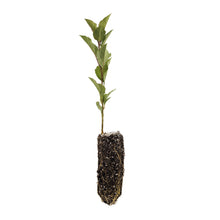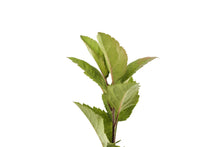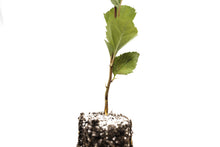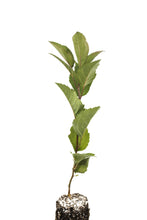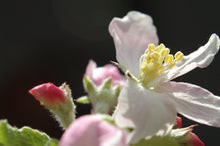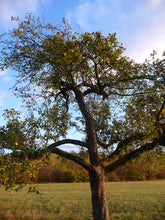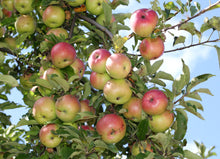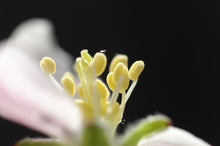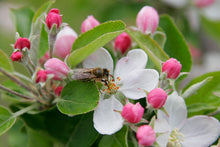
Malus pumila
-
Grow your own Common Apple, a lovely wild tree and the most widely grown apple species in the world
- 100% guaranteed
- Seed-grown on California's Redwood Coast
- Transplanting and care instructions included
 |
Moisture Medium |
 |
Cold Hardiness -40°F |
 |
Light Full Sun / Partial Shade |
 |
Size 5 – 30' tall / 5 – 30' spread |
 |
Lifespan 50 yrs |
 |
Growth Rate Medium |
 |
Drought Tolerance Low |
 |
Wind Resistance Medium |
About Malus pumila
Apple trees have been cherished and cultivated for thousands of years by people of many cultures from every corner of the world.
The “common” apple tree, as we know it today, is a species known as Malus domestica or, synonymously, Malus pumila. This tree comes from a wild ancestor, Malus sieversii, that grows in the mountains of Central Asia, Kazakhstan, Kyrgyzstan, Tajikistan, and northwestern China.
The amazing and generous apple tree has been one of humanity’s favorite trees — growing alongside us throughout most of recorded history. It was perhaps 10,000 years ago that farmers in the mountains of Asia first began growing and “domesticating” apple trees. From there, merchants transported apple trees and apple seeds along the legendary overland and maritime Silk Road trade routes into Europe and throughout the Western World. Greeks grew apple trees, as did the Romans after them, and long before the close of the First Century A.D., the beloved apple tree was dispersed to the far reaches of the known world.
Centuries later, colonists, bringing seeds from Europe, introduced apple trees to the North American continent. By the early 1600’s, North America’s first recorded apple orchard had been planted in Boston, and by the mid-17th Century, apple orchards were proliferating along American trade routes and on colonial farms. These early apple orchards were planted primarily to support cider production. North American colonists deemed apple cider safer to consume than water, and adopted it as the national drink. Consequently, cider became a highly valued and heavily traded commodity, and production of cider became foundational to the colonial economy. Apples fit for eating (sweet and fine-textured and delicious, as we know them today) were not reliably produced in these early orchards. Tasty and valuable apple cider, however, could be counted on.
In modern times, the fruit and nursery industry has greatly colored people’s perception of apples and apple trees. Most apples in early America did not taste great. They were not particularly appetizing to look at either, appearing in odd sizes and shapes with inconsistently colored, often rough and russetted skin. Nowhere were the Gravensteins, Granny Smiths, Jonathans, Red Delicious, Honeycrisps, Pink Ladies, Galas, and Fujis so ubiquitous today. These well-known and loved modern apple varieties are all produced from trees sequestered by fruit farmers and reproduced using vegetative propagation and grafting to ensure perfect genetic consistency. Seed-grown apple trees will not produce a predictably delicious fruit. When apple growers in Washington State developed their multi-billion dollar fruit industry in the 20th Century, all the trees they used were carefully grafted cultivars of tried and true apple varieties with precisely known fruiting characteristics.
After thousands of years of cross-pollination, today’s seed-grown apple trees are genetically more related to crabapples than their wild ancestors. Apple trees are members of the rose family, and are generally small- to medium-sized trees which burst with lovely five-petaled white-to-pink blooms each spring and adorn themselves with ripening orbs of growing fruit throughout the summer. Apple trees are deciduous, losing their mid-sized serrated leaves each autumn. Apple trees typically grow to heights around 15 feet, but in the wild they can stretch to more than twice that height. While they can live to more than 100 years of age, apple trees have a typical lifespan closer to 50 years.
About Jonsteen's Seedlings
All of our trees are seed-grown at our nursery on California's Redwood Coast, which is inspected monthly and licensed by the California Department of Agriculture. Trees can provide a natural barrier against high winds, temperatures, noise pollution and soil erosion, all while benefiting local air quality, wildlife and property values — a Jonsteen seedling will only grow in value and beauty
About Jonsteen's 100% Guarantee
All of our trees are guaranteed to arrive healthy and in good condition. If your tree perishes despite your honest efforts, we will be happy to replace it with a small-sized seedling for just the cost of shipping/handling. You can learn more about our guarantee and tree replacement policy here.
Seedling Size Chart: Medium
Due to the dynamic nature of actively growing trees, as well as the tremendous variation between species’ growth rates, we rely on the cubic volume of a seedling’s root mass to determine its “size” (Small / Medium / Large / XL). Within each size there is minor variance — the dimensions provided here represent the category minimum. If exact measurements are essential, please contact us about current stock.










